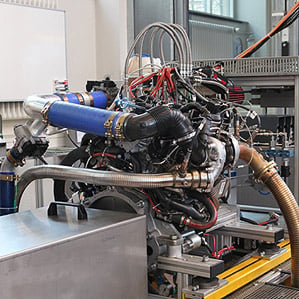Swiss Researchers Make an 80-mpg Hybrid
If electric vehicles don’t take off, maybe we can achieve fuel economy targets with cars that combine a little bit of everything.

Researchers at the Swiss Federal Institute of Technology in Zurich have developed an ultra-efficient new engine that runs on a combination of natural gas and diesel. When combined with a battery and electric motor to make a hybrid vehicle, it could allow a car to get the equivalent of 80 miles per gallon, the researchers say. That’s far better than the 50 miles per gallon you can expect from the most efficient existing hybrids such as the Toyota Prius. The only catch would be finding both natural gas and diesel for refueling.
In theory, the technology could provide an alternative to electric vehicles and plug-in hybrids for achieving strict fuel economy standards around the world. In Europe, the standards require cars to achieve the equivalent of 55 miles per gallon, on average, by 2020. In the U.S., vehicle fleets need to hit that target by 2025. Doing so will inevitably require automakers to sell some vehicles that surpass those targets to offset emissions from SUVs and other larger vehicles.
Christopher Onder, a senior scientist at the Swiss Federal Institute, says the new design could provide “a bridge to when electric vehicles are really affordable.” The researchers estimate the technology would add about $8,000 to the cost of a conventional gasoline-powered car. Some electric vehicle technology costs far more. The electric version of the Ford Focus, for example, costs $19,000 more than the gas-powered one.
The Zurich researchers modified a diesel engine, which is already very efficient, to run on natural gas, which reduces emissions compared to burning diesel. To allow a diesel engine to run efficiently on natural gas, the researchers injected a little diesel fuel at certain points to get the natural gas to ignite properly. The diesel accounts for 10 percent or less of the total fuel burned in the engine. The battery and electric motor kick in when the engine would run less efficiently, reducing emissions still more.
Natural-gas-powered cars already exist, but they have a shorter range than gasoline-powered cars by about 100 miles. But this isn’t the case with the new design, since the engine is so efficient, which would allow a vehicle to travel farther per liter of natural gas.
The researchers aren’t the first to try combining two fuel tanks in one vehicle. Others have developed engines that run on both gasoline and diesel (see “Reinventing the Gasoline Engine”). And injecting gasoline and ethanol into an engine separately (rather than blending them in fuel, as is done now) has been shown to improve fuel economy (see “The Incredible Shrinking Engine”). There have even been previous natural gas and diesel combinations for large engines, though not for cars. While these concepts have been around for years, they’ve yet to catch on. “The major hurdle is to get consumers used to the idea of using two fuels,” says Rolf Rietz, a professor of engineering at the University of Wisconsin at Madison.
The new technology would be more expensive than an ordinary hybrid because diesel engines can cost thousands of dollars more than gasoline ones, and batteries and motors also add thousands of dollars. “This is a costly approach, and attractive results may be obtained with less cost and complexity,” says Larry Rinek, a senior technology consultant at Frost and Sullivan, a consulting company.
The technology could compete with plug-in vehicles, which can achieve similar emissions on short commutes by traveling on electricity stored from the grid before using gasoline. But plug-in hybrids could, in fact, be more expensive than the new technology. The Ford C-Max Energi plug-in hybrid, for example, costs $16,000 more than a similar gasoline-powered car.
Also, the efficiency of plug-in vehicles drops after the stored grid electricity is used up. In contrast, the new vehicle design would retain its fuel economy for long trips.
Keep Reading
Most Popular
Large language models can do jaw-dropping things. But nobody knows exactly why.
And that's a problem. Figuring it out is one of the biggest scientific puzzles of our time and a crucial step towards controlling more powerful future models.
The problem with plug-in hybrids? Their drivers.
Plug-in hybrids are often sold as a transition to EVs, but new data from Europe shows we’re still underestimating the emissions they produce.
Google DeepMind’s new generative model makes Super Mario–like games from scratch
Genie learns how to control games by watching hours and hours of video. It could help train next-gen robots too.
How scientists traced a mysterious covid case back to six toilets
When wastewater surveillance turns into a hunt for a single infected individual, the ethics get tricky.
Stay connected
Get the latest updates from
MIT Technology Review
Discover special offers, top stories, upcoming events, and more.